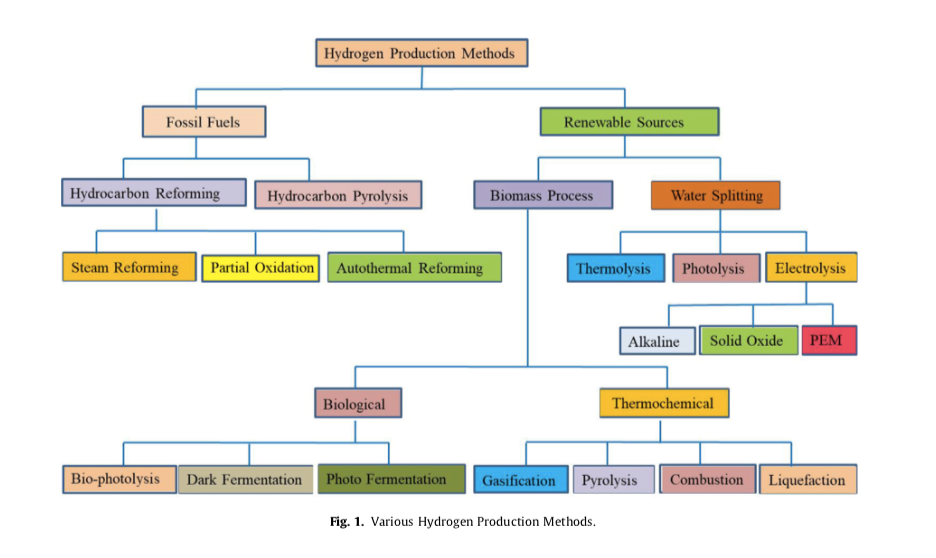
Renewable Hydrogen: The Future of Storage and Fuel of the Future?
Storage still remains a challenge for renewable energy. Creating renewable hydrogen—through electrolysis—could be the answer.
As necessity is the mother of invention, engineers and entrepreneurs are developing novel technologies to store energy, such as gravity storage. Today, almost all grid storage in the United States is pumped hydro. Even assuming rapid technological improvements, lithium-ion batteries are projected to be far too expensive and not resilient enough to satisfy grids with over 80% renewables. The sheer quantity of storage required by carbon-neutral regional grids and the relative success of battery storage in microgrids suggests they are better suited for the latter.
But renewable hydrogen is another promising option. The different methods of hydrogen production are shown in Figure 1. This article focuses solely on electrolysis. Here’s the idea: renewables generate excess electric current when power supply outstrips demand. The current could electrolyze water, creating hydrogen that can be pumped directly into modified gas pipelines, or stored underground or in large tanks. (The most promising electrolytic method, proton exchange membrane (PEM), can react quickly to renewable fluctuations and is already used in some distributed systems.)

The realization of hydrogen electrolysis is dependent on a few economic developments, the first of which is the expected decline in wholesale power prices. Cheap surplus renewable energy will reduce the clearing price generators are paid. To arbitrage this opportunity it makes most economic sense to install small-to-medium electrolyzers next to wind farms and solar parks to store hydrogen energy when the power supply is high and then sell it on the grid when the power supply is low, or sell the hydrogen gas itself for commercial purposes. One recent study in Nature found that renewable hydrogen is viable for small- and medium-scale purposes when sold at $3.25/kg in Texas.
Of course, one key impediment is the cost of installing the infrastructure to store all the hydrogen. $637 billion worth of storage infrastructure needs to be built for hydrogen to provide the same level of energy security as natural gas. Overall, hydrogen is about 1.5 to 5 times more expensive than natural gas.
Yet electrolysis has a number of advantages over other technologies, not least of which is its ability to scale to meet demand. Hydrogen also benefits from having numerous industrial and energy applications. Cheaper hydrogen gas could be used to help produce cement, synthesize ammonia, heat households, replace coal in steelmaking, refine metals, and power ships. The electronic components used for large electrolyzers are still custom designed, but as deployment of this technology increases, electrolyzers of all sizes will benefit from economies of scale and mass production of key components.
Electrolyzer technology has already dropped by 40% in the past 5 years through R&D. The energy efficiency of commercialized water electrolysis is 70-80% compared to the 65% of typical hydrogen production, steam reforming from methane. Honda, Hyundai, Toyota, and BMW are committed to hydrogen fuel cells for vehicle combustion, because of quick refueling and long range. Even if hydrogen fuel cells don’t beat electric batteries, the automakers’ R&D discoveries may carry over to other useful applications. Declining acquisition costs for wind turbines and electrolyzers motivate the Nature study authors to forecast renewable hydrogen becoming viable for large-scale industrial supply within a decade. Indeed, many large hydrogen projects are already in progress.
Energy policy must keep pace with the promise of renewable hydrogen. The U.S. federal government grants tax credits to solar photovoltaic and battery storage installations, but not for renewable hydrogen, disincentivizing the latter and distorting the market. Tax credits should be extended to renewable hydrogen to level the playing field. Federal regulations should also be simplified and clarified as much as possible, and reduced to compensate for the current economic and legal uncertainty regarding energy storage technologies and deployment. For example, large electrolyzers that use renewable power could be exempted from grid fees and levies, like those granted to industries such as aluminum, paper, and chlorine.
Joshua Anumolu
Undergraduate Seminar FellowJoshua Anumolu is an undergraduate student studying in the College of Arts and Sciences. Anumolu was a 2020 Undergraduate Student Fellow.

